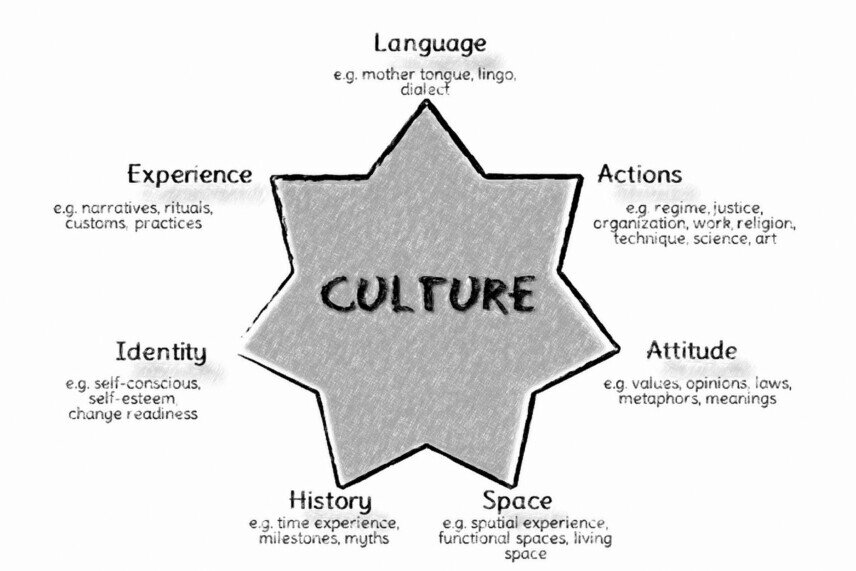Cultural aspects
Culture is everything people materially and idealistically create, do, and use - things, systems, behavior, and thinking. It becomes visible in social, organizational, family, and similar communities and the personality of individuals. Because of different cultures, individual types, and hard to observe elements, the preoccupation with culture requires a lot of time, expenditure, patience, and a structure for the description. This model offers substantial features for the definition of cultures. The conscious collection and transfer of cultural aspects facilitate access to other cultures.
Cultural aspects consist of seven areas: Language, actions, attitude, space, history, identity and experiences.

- Language
is a system of tokens, terms, and rules that a group of people shares. Everyone has several languages used in parallel, e.g. native language, foreign languages, jargons, and dialects. The characteristics of a language provide indicators for cultural characteristics. An example is the Japanese token of thought (思い that consists of a heart under a rice field, which links thinking to feeling.
- Actions
are visible acts that are typical for a group of people. They can be found, for example, within the areas of the regime, law, work, religion, and art. Thinking can be derived from actions. For instance, nature-related religions speak for a close relationship to nature.
- Attitude
includes elements that are often used synonymously with culture. This includes values, opinions, laws, and meanings. They form the basis for mental models, which strongly affect the act subliminally. Thus a so-called high-context culture (e.g., Japan) requires a long-term integration of people into a social system to understand expressions that contain many assumptions (e.g., the reference to a person’s birthplace implies unique, local convictions).
- Space
describes the handling of places, areas, distances, and borders of coherent regions - geographical and abstract. This includes spatial experience, functional spaces, and living spaces. An example of spatial experience is the distinction between private and public space and related behavior. The preference of the private area indicates a trend to the larger distance from others. In functional spaces, e.g., an apartment, various cultural characteristics are subsumed (e.g., allocation, size, and appropriate behavior). Accordingly, culture is defined (e.g., handling of historic buildings).
- History
describes the usage of aspects of time, like time experience, milestones, and myths. Time experience is well expressed in the saying, „the way is the goal “. This saying does not focus on target achievement, but the continuous, ‚infinite’ occupation. For cultures that practice this thinking, concrete, exactly scheduled goals are not so important.
- Identity
is the amount of metaprograms that characterize a group of people. This includes, for example, self-confidence, self-esteem, and change readiness. Self-confidence and self-esteem describe, for instance, impression, evaluation, and classification of their self. This results, depending upon culture, in different approaches of group work and discussion styles.
- Experience
is the sum of undergone incidents and the sum of the experiences of a group of people. These are expressed in narratives, rituals, customs, and practices. Experiences are seldom pronounced, form a common state of knowledge in the context of a lifestyle, and can only be determined with difficulty by outsiders. Examples are the Chinese proverbs, the so-called Chengyus, which consist of four signs (e.g., old man loses horse) and a lengthy explanation with a moral of the story (in this case: Blessing in disguise).
Culture works anywhere and anytime. For this reason, culture should be considered in all activities, whether it may be business modeling or strategy development.

